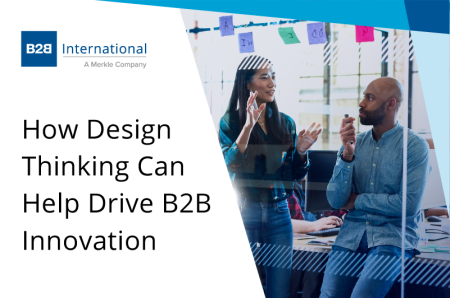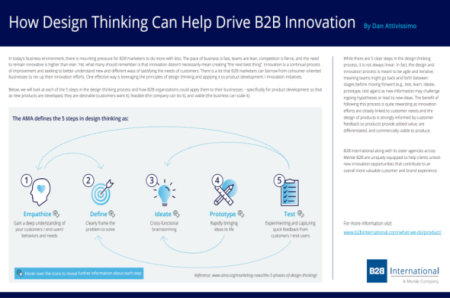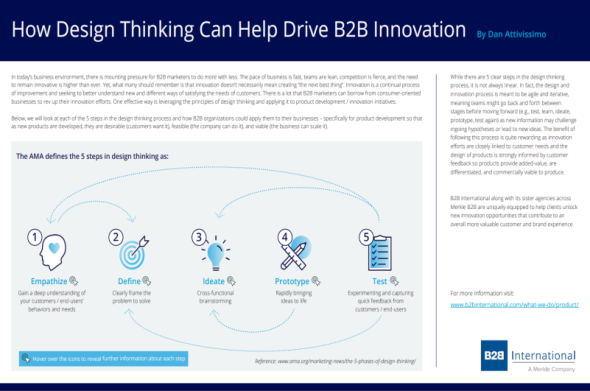
In today’s business environment, there is mounting pressure for B2B marketers to do more with less. The pace of business is fast, teams are lean, competition is fierce, and the need to remain innovative is higher than ever.
Yet, what many should remember is that innovation doesn’t necessarily mean creating “the next best thing”. Innovation is a continual process of improvement and seeking to better understand new and different ways of satisfying the needs of customers.
There is a lot that B2B marketers can borrow from consumer-oriented businesses to rev up their innovation efforts. One effective way is leveraging the principles of design thinking and applying it to product development / innovation initiatives.
The AMA defines the 5 steps in design thinking as:
- Empathize – gain a deep understanding of your customers / end-users’ behaviors and needs
- Define – clearly frame the problem to solve
- Ideate – cross-functional brainstorming
- Prototype – rapidly bringing ideas to life
- Test – experimenting and capturing quick feedback from customers / end-users
In this article, we will look at each of the 5 steps in the design thinking process and how B2B organizations could apply them to their businesses – specifically for product development so that as new products are developed, they are desirable (customers want it), feasible (the company can do it), and viable (the business can scale it).
Empathize – Understanding the Customer’s Needs
Design thinking is often associated with terms such as “human-centered design” or “user-centered design”. This underscores the clear link between the business and people – after all, businesses serve people.
The first step in the design thinking process is to bring a deep understanding of the customer or more importantly, the end-user, into the process. Oftentimes, B2B organizations rely on internal customer-facing functions such as the sales teams or customer service to act as the voice of the customer. While helpful, this provides a limited view of the true customer experience.
It is therefore crucial to capture the customer’s point of view in an unbiased way and to step into their shoes to better understand their goals, motivations, behaviors, challenges and unmet needs. Leveraging primary research such as ethnographies, focus groups, or in-depth interviews with customers and developing decision making eco-systems, buyer personas, and customer journey maps are excellent tools for building foundational knowledge about B2B customers.
Define – Identify the Problem to Solve and Develop a Clear Brief
Famous inventor, Charles Kettering, once said “A problem well-stated is half-solved.”. Truer words have not been spoken when it comes to innovation. To inspire creative ideas, there needs to be a clear problem to solve. By gathering customer insights from the empathy stage (and other resources) and looking for common trends or themes, teams may start to identify certain opportunity areas to plan to innovate around. It’s not uncommon for several opportunity areas or unmet needs to exist.
However, it’s important for organizations to prioritize which to attack first. This step could also help to build a pipeline of opportunities to explore over the near, mid, and long term. The output from the ‘Defining’ stage is typically a well-crafted brief with a strategic focus, clear objectives, and inspiration that can guide both design and research later in the process.
Ideate – Unleash Creativity and Generate Potential Solutions
Armed with a strong foundation of customer knowledge and a clear direction on what problem to solve, it’s time to bring together a cross-functional team to collaborate and generate ideas for solutions. The purpose of these sessions is to focus on the main problem to solve – per the brief coming out of the Defining stage – and to generate as many possible solutions as possible. During these collaborative brainstorming sessions, it’s critical to create an environment that encourages divergent thinking – where everything from mild to wild is acceptable. Once all ideas are on the table, the goal will be to begin converging on a few high potential ideas worth pursuing.
The converging process is often where the blue-sky thinking gets a dose of reality and constraints are applied. Using tools such as a SWOT, customer value proposition, or impact/feasibility frameworks can be helpful in prioritizing which opportunities to pursue first. By the end of the Ideation stage there should be several potential concepts (and alternatives) as well as hypothesis about benefits to further explore.
Prototype – Rapidly Bringing Ideas To Life
Quickly bringing new product concepts to life in a way that customers / end-users can engage and interact with is a critical component for how B2B organizations can leverage design thinking in their innovation process. This step is mostly led by the product design team who take inspiration from the ideation stage and think of ways that the company could feasibly bring a new product to market. Depending on the subject, prototypes could take the form of 3D printed models, renderings, concept statements, wireframes, etc.
The intent of the prototyping stage is to quickly design stimuli for testing that customers / end-users can understand, react to, and provide feedback on how it may / may not work for them or their organization. Often there are several concepts and alternatives developed that each represent a unique benefit. The purpose of this is to isolate variables and build upon what is working.
Early in the innovation process these conceptual prototypes don’t necessarily have to be perfect – a term that is often used in this space is Minimally Viable Product (MVP). That means if the prototype is at a high enough fidelity for the general idea to be understood, it should be good enough for testing. As the concepts move closer to commercialization, the need for higher fidelity prototypes increases (i.e., close to a final working product).
Test – Agile Feedback from Real Customers
The once conceptual ideas have been brought to life via prototyping and are now ready to be tested with customers / end-users. Although many associate product testing with quantitative benchmarking (which is appropriate at times), a qualitative approach can help product teams dive much deeper into the “why” and “how” of the feedback to truly understand how a potential product idea may be used in real world applications.
One common pitfall at this stage in the process is allowing customers to drive the innovation process. While customer feedback is extremely important, learnings need to be validated with business experts who understand both feasibility and strategy. This is especially true with upstream innovation (i.e., where product concepts are still in their infancy) and learnings are used as building blocks to continue informing the design process.
The key to the testing stage is to go in with a clear set of hypotheses and action standards / success criteria that can help inform go/no-go decisions for winnowing down the number of concept candidates to further pursue.
While there are 5 clear steps in the design thinking process, it is not always linear. In fact, the design and innovation process is meant to be agile and iterative, meaning teams might go back and forth between stages before moving forward (e.g., test, learn, ideate, prototype, test again) as new information may challenge ingoing hypotheses or lead to new ideas. The benefit of following this process is quite rewarding as innovation efforts are closely linked to customer needs and the design of products is strongly informed by customer feedback so products provide added-value, are differentiated, and commercially viable to produce.
B2B International along with its sister agencies across Merkle B2B are uniquely equipped to help clients unlock new innovation opportunities that contribute to an overall more valuable customer and brand experience.
References
https://www.ama.org/marketing-news/the-5-phases-of-design-thinking/




